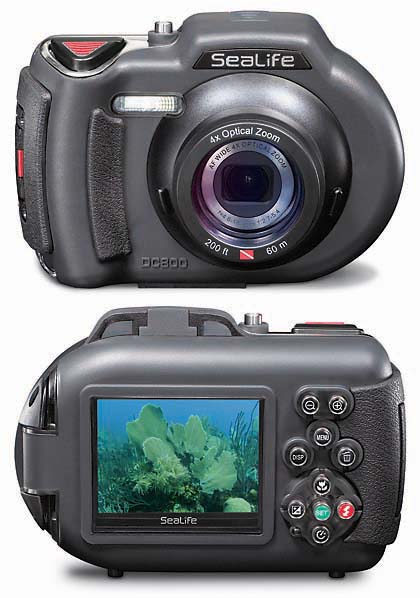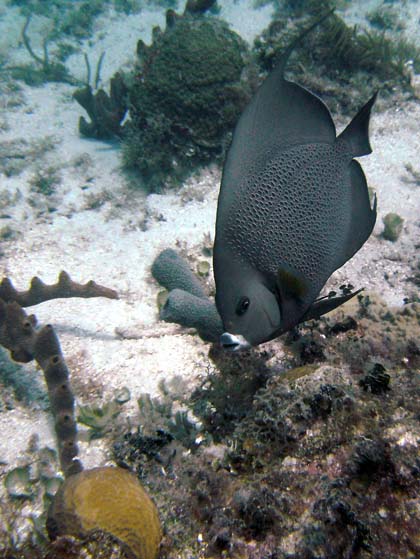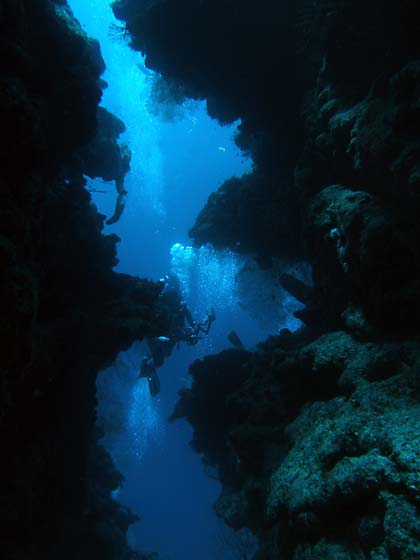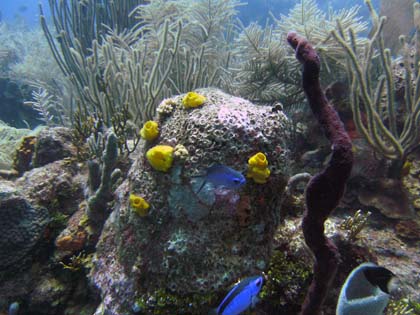|
SeaLife DC800
Excellent underwater, and above
(by Conrad H. Blickenstorfer; photography by Carol Cotton)
This is a review of the SeaLife DC800 digital camera that you can use both under and above water. It consists of a standard (but modified for underwater performance) 8-megapixel digital camera and a very tough underwater housing. Underwater you can use it to a depth of 200 feet. Out of its housing, it is a small and handy digital camera that you can take and use anywhere. The SeaLife DC800 with its underwater housing has a list price of US$549.95.

Who is SeaLife?
Who is SeaLife? The name is popular in the scuba diving community but the company is not so well known among regular photographers, so here's the scoop: SeaLife is part of Pioneer Research, which is the North American headquarters of Steiner binoculars, and also the worldwide headquarters for Vero Vellini hunting slings and straps, and, of course, SeaLife cameras. Being into optics and outdoors equipment, the company is dedicated to the outdoor and sports experience. SeaLife cameras have been around for about 15 years, and the company introduced the first underwater digital camera in 2000. Today, SeaLife prides itself in offering a whole array of underwater cameras and accessories, with all the flashes and lenses interchangeable with any SeaLife camera.
I must admit that before my diving days, I had never heard of SeaLife myself. That quickly changed a couple of years ago when we tested some very competent underwater cameras from major manufacturers. We came up with decent underwater shots, but they were nowhere near as good as those that my dive buddy took with her SeaLife DC500 camera. I was intrigued and wondered how the fairly basic SeaLife hardware could do so well when we struggled with cameras that, at least based on their spec sheets, should have produced superior results. I initially wrote it off as being unfamiliar with our test cameras, and that certainly contributed as our results improved quite a bit once we got to know the cameras, but the SeaLife DC500 still did better. This was reaffirmed when Carol shot several hundred underwater pictures on Little Cayman with her SeaLife, with spectacular results.
 Angelfish seems interested in our DC800
Angelfish seems interested in our DC800
SeaLife's secret sauce
Having founded Digital Camera Magazine in 1998 as the first print magazine dedicated entirely to digital cameras, I am quite familiar with the technology and what digital cameras could, and can, do. So I took a closer look at SeaLife's offerings and concluded that it simply could not be the camera hardware alone that made for such excellent image quality. That's because there is nothing special about the SeaLife hardware. It is, in fact, quite generic. SeaLife does, however, have a secret sauce and it lies in the company's understanding of underwater photography. As a result, they made some subtle software and settings changes, added several underwater modes, and also some excellently designed and engineered peripherals, and, voila!, superior photography. Talent and experience still play a role, of course, and so it certainly didn't hurt that Carol is an award-winning photographer.
Every diver knows that things are different underwater. Sound travels much faster, objects seem closer than they actually are, there is almost always some debris floating around, and colors change and shift according to depth. Consumer cameras that offer optional underwater cases usually have at least one underwater shooting mode, and sometimes several. But they still don't seem truly optimized for the very different underwater environment. So colors seem off, and the built-in flash goes off when it shouldn't, resulting in "scatter," i.e. illumination of particulates that all but obliterate the picture. SeaLife cameras are smarter. By doing simple things like offering white balance modes that take the changing nature of light underwater into consideration, image quality can improve drastically and pictures jump to life. The proper external flash is also extremely important, and SeaLife is eminently aware of that.
So what is the DC800?
The DC800 is what SeaLife simply calls an "underwater digital camera." The approach here, however, is different than the one Sealife took with its ECOshot that we also tested extensively. While the ECOshot is a super-rugged camera that's essentially embedded in a very tough housing, the DC800 is a system that consists of a standard digital camera optimized for underwater use, and a dedicated underwater housing that can go deeper than the optional housings available for a number of consumer cameras from the likes of Olympus, Casio, Pentax and so on.
 Squid were swimming circles day-in, day-out
Squid were swimming circles day-in, day-out
Take a look at the DC800, however, and it's instantly clear that this is an entirely more serious product. While most consumer camera underwater cases are clear acryllic accented by bright and friendly colors, the DC600 case is all business. It is a tough, industrial looking polycarbonate affair with extensive rubber overmolding. And the rubber molding is not just for decoration either. It looks as thick and tough as if it belonged on a Caterpillar's tires. There are some stainless steel elements in the front that brighten things up, but this is very clearly a tool for the job. Why does SeaLife go to such lengths? Because underwater it's not just a matter of withstanding water pressure. Cameras also bump against rocks, get dragged along the bottom, and are just generally exposed to much more abuse than above water.
 Swimming through Calvin's Crack, one of Roatan's famous dive sites
Swimming through Calvin's Crack, one of Roatan's famous dive sites
The SeaLife DC800 housing is individually depth tested to 200 feet, which means it can go a lot deeper than the recommended recreational diving depth limit of 130 feet. It's also been our experience that depth ratings are usually conservative, so tech divers can probably rely on this camera a good deal beyond 200 feet (which, of course, we don't recommend). In our tests off Roatan island in Honduras, we took the camera down to about 100 feet--child's play for this camera.
Despite its tough look and feel, the case itself is very user friendly. Unlike some 2-piece underwater cases that are quite difficult to open and close, the DC800's is a hinged clamshell with a simple snap. Make sure the thick rubber o-ring is not damaged and that there's no sand, hairs or fibers sticking to it, and then just close it. The case is easy to hold and has excellent grip. The controls are easy to use as well. There are 10 push buttons, all with white on black markings except for Set (green) and Flash (red). There is also a standard steel 1/4-20 tripod thread, and a snap-on ring allows mounting of accessory lenses.
When we reviewed the older DC600, we had a couple of criticisms. First, the camera had a slider mode switch that let you select still image, video, and replay. That switch could not be operated while the camera was in the underwater case, meaning that you could neither review pictures while underwater nor switch from still to movie mode. I routinely do both, and not having that capability was an issue for me. The other criticism was about the location of the safety that locked the snap. It was right where your thumb was, and I found myself worrying that I'd accidentally undo it, especially with gloves on. Well, on the DC800, SeaLife fixed the safety issue by moving the snap so that it can no longer open accidentally. The mode switching issue is also fixed, though it is not very obvious. See, while the underwater housing does not provide access to the mode switch located on top of the camera, pushing the Display button while the camera is in any of the underwater modes will cycle through still, movie and playback modes. This was probably also the case with the DC600 and we never noticed!

Specifications and features
In terms of specifications, the DC800 is your standard modern 8-megapixel digital camera. You get 3264 x 2448 pixel in maximum resolution -- enough for cropping, zooming in, and making enlargements. Resolution, of course, is a moving target and consumer cameras are now in the 10-14 megapixel range. SeaLife is usually quick to follow suit for models that can be used both above and under water, but 8-megapixel means the DC800 is not going to be obsolete anytime soon. You can set the camera to various lower res modes and also vary image compression if storage space is an issue. The camera comes with 32MB of onboard memory and a SD Card slot that can handle the new large capacity SDHC cards (up to 16GB cards have been tested). Focal length is 4.6 to 18.4 millimeters, or 28 to 112mm in the old 35mm film camera parlance. This means you're now getting a full 4X optical zoom that starts slightly wide compared to the DC600's 3X zoom. Movies record at 25 frames per second at 320 x 240 or 640 x 480 pixel format and the camera records sound with movies, even underwater. Sensitivity is improved compared to earlier SeaLife cameras. In addition to leaving the camera in automatic mode, you can set to 64, 100, 200, 400, 800 or even 1600 ISO. The normal focus range goes from a foot to infinity. A macro range let's you get as close as a couple of inches. There is a self-timer, exposure compensation, and a 5X digital zoom on top of the 4X optical zoom. The built-in flash has four modes: automatic, on, off, and red-eye reduction.
The 2.7-inch display is bright, sharp (230k pixel resolution now!) and large enough. Today's digital cameras, for the most part, no longer have optical viewfinders, and the DC800 doesn't have one either. Today we depend on the LCD which can be difficult in bright sunlight and at times underwater. SeaLife knows that and lets you crank up the LCD to very high brightness, something that we appreciated very much underwater.
The DC800 is a point & shoot camera that you set either in a program automatic mode or one of almost two dozen scene modes. The scene modes are:
- program AE
- sea
- external flash auto and manual
- panorama
- portrait
- landscape
- sport
- night
- night portrait
- night scene
- candlelight
- text
- sunset
- sunrise
- splashing water
- flowing water
- beach
- pets
- anti-shake
- AV (aperture priority)
- TV (shutter priority)
- user setting
It's easy to overlook the manual AV (F2.7 and F5.3) and TV (from 1/1000th to 1 second) modes as they are not described in the brief but otherwise very good manual. Make sure you try them out as proper depth of field can make a huge difference in underwater photography.
In "Sea" mode, for use without external flash, you can select special underwater white balance modes that make a huge difference. In the SeaLife DC600 we reviewed last year, there were white balance modes for shooting in depths of up to 25 feet and one for shooting below 25 feet. That was because red only penetrates about ten feet and orange disappears at 25 feet, so a white balance that takes that into consideration really matters. In the DC800, you no longer set by depth. Instead you can select:
- Ocean Blue (for blue water conditions, like tropical reefs)
- Ocean Green (for colder water and water with a lot of algae)
- Lakes/Rivers
You can also set the white balance manually (our MAXX package included a white balance calibration card for underwater) , and we've had very good results with that as well.
The other underwater mode, "External Flash," is used with one of SeaLife's impressive external flash accessories, and those are a must-have for serious underwater photographers. In fact, the company sells the DC800 in packages that include an external flash and extra accessories. There are the DC800 Pro Set (single SL961 flash) and the DC600 Digital MAXX (dual flash, wide angle, travel case, chargers) set SeaLife sent us for our review.
The DC800 also has a special "Spy" mode that makes the camera take pictures at set time intervals from 10 seconds to 60 minutes. This can come in handy for taking pictures of critters that don't like a lot of commotion closeby. And on land you can put the camera on a tripod and do some sequential shooting. There is no "SHARK" mode like the older DC500 had for rapid-fire operation; that's because the DC800 doesn't need it. When set to "landscape" focus, the camera has very little shutter lag.
Overall, the DC800 is a great example of SeaLife's expertise of taking standard digital camera hardware that can be used anywhere, adding special firmware and settings for use underwater, and packaging the camera with a simple, but first-rate underwater housing and external flashes.
The special underwater white balance modes of the DC800 make all the difference. This way you get a camera that works just like a standard digicam on land, and takes pictures like a dedicated underwater camera while diving. The case is superb as well. It can easily handle all recreational diving and a good deal beyond.
SeaLife external flash system
When it comes to taking pictures underwater, flash is everything. There is a world of incredible color down there, but you cannot always see it because colors are different underwater. Colors are really nothing more than different wavelengths reflected by an object. Underwater, waves travel differently, and some wavelengths are filtered out by water sooner than others. Lower energy waves are absorbed first, so red disappears first, then orange, then yellow. Green stays longer and blue the longest, which is why things look bluer the deeper you go. So if you want to capture all those wonderful colors, you need a strong flash, and that is where the SeaLife Digital Pro Flash comes in. SeaLife sells packages with a single or a dual flash. Each flash needs four AA batteries. You can use single-use Lithiums which last a long time but are quite expense, or rechargeable NiMH batteries.
Our MAXX package came with the dual flash, which is perfect for best possible illumination of subjects. SeaLife uses an optical flash link that snaps onto the underwater housing. It covers the internal flash window so it can pick up the firing of the camera's flash without letting the internal flash illuminate debris that results in "scatter" on images. Each of the two Digital Pro Flashes has a pre-flash and an automatic mode switch that can be set to accommodate SeaLife or non-SeaLife cameras. Each flash also has an external flash intensity control knob that can be set to automatic or manual control of flash intensity, from darkest ro brightest. In our experience, the Digital Pro Flash shot very bright. If anything, we had to tone it down; we certainly never lacked firepower.
While the flashes add size and bulk to the camera setup, that becomes much less of an issue once you are underwater. Each flash arm is tightly wrapped in grippy foam, and each arm can easily be adjusted separately.
Do allow time to get used to the flash. Getting acquainted with an underwater camera takes much longer than figuring out how things work on dry land. Add an external flash system and the learning curve gets longer yet and it may take a while to get good results. Don't give up, though. Once you get the hang of it, you'll be rewarded with wonderfully rich, colorful pictures.

Shooting underwater
If you're a seasoned underwater photographer you already know that taking pictures underwater is totally different from taking pictures on dry land. Above water, things are fairly simple for a camera: measure light, focus, and shoot. Underwater, there is always less light and so many things move in the water that it is very easy for the camera to become confused and focus on the wrong thing. Water is also not always clear and that can throw off the camera as well. If you use the flash, the bright light from the flash can illuminate particles and debris in the water, resulting in "backscatter," a picture dotted with brightly lit particles. All of this means that the rules of underwater photography are quite different.
Clear water and great visibility are essential, but rarely present. As a rule of thumb, keep shooting distance to 1/10th of visibility. Turn off the internal flash to eliminate backscatter. Forget about the pristine landscapes we all like to take on dry land; underwater it is best to shoot within two and six feet. Another issue is holding the camera still. Above water that's fairly easy but underwater you're weightlessly flying, floating and hovering, so good buoyancy is essential. The DC800 with its flashes is positively buoyant (there is an adjustment weight that you can screw on) and you need to get used to that. Since everything moves, and there may have to fight surge and current to boot, the camera is often hunting for the best possible exposure and focus. We followed SeaLife's advice and set the camera to landscape/infinity focus. That way everything beyond about a foot and a half was in focus.
If you consider the above, you still need to observe the three primary rules: First, read the entire manual very carefully and figure out how the camera works, exactly. Second, practice, practice, practice. That is more important underwater than anywhere else. Third, don't just take the perfect shots; shoot as many pictures as you can, even of the same subject. The conditions underwater are such that many pics will be junk and you'll delete them later. That is normal and happens even to seasoned underwater photographers (and not just underwater). So, shoot, shoot, shoot.
We also found that each underwater camera has its own personality and you need to get used to it. With the DC800 we quickly learned that while there usually is not enough flash power with most cameras, the two big external flashes provided so much that we had to play with its external adjustment knobs. And while I rarely use exposure compensation when I shoot above ground, with the DC800 I often got the best results by setting exposure compensation to -1 or even -1.5. The camera also has an Auto Exposure Bracketing mode that takes three shots of the same subject (if it holds still long enough) with different exposures.
If you consider the above, an underwater photography trip with the SeaLife DC800 will reward you with unforgettable pictures and video from a fantastic world few are ever fortunate enough to see.
SeaLife DC800
We like:
- Great, very handy underwater camera with generous 200 feet depth limit
- Without housing, it's a small and handy digital camera for use anywhere
- Tough, rugged housing very simple to use and operate
- Takes good pictures above and under water
- Powerful battery
- Appreciate the new 4X optical zoom!
- Shutter priority and (limited) aperture priority modes
- Special underwater white balance modes make for great pictures
- SeaLife's optional strobes and lenses
Keep in mind:
- Some O-rings can pop out, so always check them!
- Like all underwater cameras, takes practice to "dial in"
|










